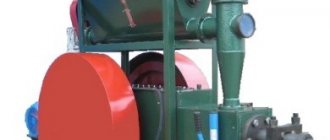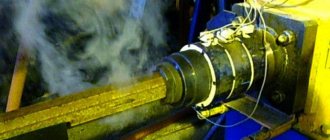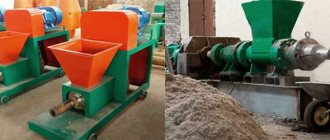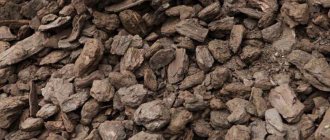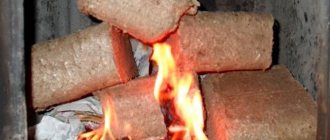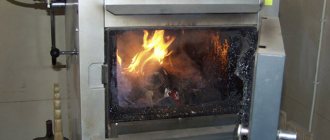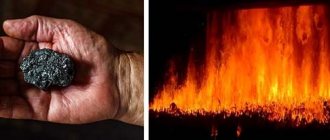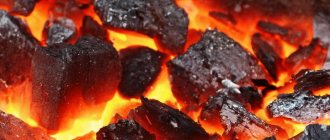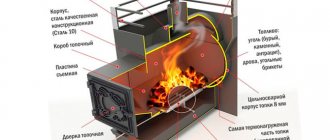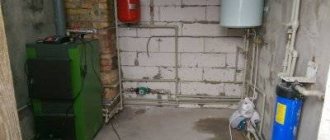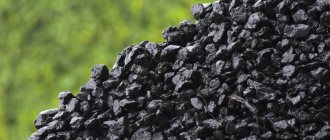Homeowners who heat their homes with solid fuel boilers and stoves know well how difficult and inconvenient it is to burn small fractions of coal, and even more so coal dust. Some of this fuel is poured into the ash compartment and ends up as waste, while the other blocks the air flow from the grate and therefore burns poorly.
The solution to the problem is to compress these small things into briquettes, which give good combustion and generate a lot of heat. Industrial coal briquetting has been used for a long time, but pressing technology can also be implemented at home. We study how to do this in this material.
Briquetting technology for hard/brown coal and coke
Coal briquetting technologies are designed to produce commercial products from coal dust, screenings, substandard and low-quality coal. Black or brown coals, as well as coke, can be used as raw materials.
Coal briquetting is a very old technology that was developed using double-roller roller presses, which increased productivity and qualitatively improved the economic attractiveness of this business.
SAHUT-CONREUR was one of the companies that began producing double roller presses at the beginning of the 20th century. We are located in northern France and, since the beginning of the 20th century, have installed more than 1000 briquetting plants in different parts of the world, of which more than 350 are for briquetting coal screenings.
The technology of coal briquetting on roller presses was developed to produce briquettes from fine coal coming after coal screens and washing. Briquettes are intended for use as fuel for private or industrial boiler houses in the same way as conditioned coal, and are also packaged for retail sale and in this form can be exported.
In most cases, the process of coal briquetting occurs with the addition of a binder (coal pitch, petroleum bitumen, tar, molasses and lime, lignosulfonate, starch, polymers...). In some cases, briquetting is also possible without a binder.
For reference
It is impractical and even pointless to send wood waste in its natural form to a furnace or boiler. Their friability leads to the fact that burnout occurs in the shortest possible time and is accompanied by weak heat transfer. In addition, a significant part of the sawdust spills from the grate into the ash pan, which reduces efficiency and increases consumption. Sawdust fuel briquettes do not have all these disadvantages. From an economic point of view, it is unreasonable not to use waste, which is available in abundance at the dacha, for one’s own purposes.
ADVANTAGES OF BRIQUETTED COAL
Technical solution:
- Receiving a product of the same size, volume, shape and weight.
- Elimination of the problem of dust formation and defects during transportation.
- Specified hardness and strength of the briquette.
- Recycling waste into commercial products
Consumer and marketing benefits:
- Higher energy value
- Longer burning
- Ash in powder form
- Less CO2 and sulfur emissions
- Easier packaging, transportation, storage
- Ready for automatic feeding into the firebox
- Possibility of packaging for the consumer market
- Export supplies
COAL BRIQUETTING WITHOUT BINDER
The binderless coal briquetting plant consists of the following components:
- coal sorting and grinding area if the coal size is too large
- drying area if the moisture content of the coal is too high
- briquetting area on a two-roller press
The capacity of a coal briquetting plant without binder can range from several tons per hour to approximately 25 t/h.
BRIQUETTING COAL WITH BINDER
The plant for briquetting coal with a binder consists of the following sections:
- coal sorting and grinding area if the coal size is too large
- drying area if the moisture content of the coal is too high
- binder addition area
- briquetting area on a two-roller press
- (optional) post-processing area (cooling, ripening and drying depending on the binder used)
The capacity of a plant for the production of briquettes from coal with a binder can range from several tons per hour to 100 t/h for large presses.
Possible binders
- coal pitch
- petroleum bitumen
- resin
- molasses and lime
- lignosulfonate
- starch
- polymers, etc.
The specific binder for charcoal briquettes is determined by regional availability and end product requirements. The optimal proportions of the binder and the parameters of the finished briquette are determined during pilot testing of coal in France.
Scope of application
Sawdust briquettes have a fairly wide functionality. This fuel can be used:
- for heating a residential building. Due to their compactness, briquettes made from wood raw materials are suitable for fireplaces, stoves, and solid fuel boilers;
- when heating baths and saunas, if your main house is heated in some other way. Briquettes ideally suit all environmental conditions;
- on picnics. They are an excellent alternative to coal and firewood. Moreover, they can boast of a remarkable property: when fat gets on a hot briquette, the latter does not ignite and does not smoke.
By the way, sawdust briquettes should probably be recommended for cooking in closed spaces: there is no burning smell, and the dish is fried extremely evenly.
Testing of raw materials and binders for coal briquettes
Coal in each specific deposit has individual chemical and physical characteristics, and different binders may be available in each region.
To accurately determine the required composition and characteristics of the equipment, it is necessary to conduct preliminary testing of the customer’s material at the manufacturer’s plant in France. To conduct tests, the customer needs to send coal to France for testing.
As a result of the tests you will be able to:
- determine the required composition and characteristics of the equipment
- determine the type and proportions of the binder
- obtain a finished briquette and determine its characteristics
- calculate accurate economic indicators of production
Also, only through testing is it possible to determine whether coal is suitable for briquetting without a binder and what the technical and economic indicators of production will be in this case, as well as the quality characteristics of the briquette.
Necessary equipment
Despite the relative ease of obtaining fuel, you still have to acquire some equipment. Or adapt existing ones to new needs. What you will need:
- Chopper. You can’t do without it, because the finer the raw material, the denser the finished briquette. And when making it with your own hands, materials of various fractions are used. You won’t have to spend money on purchases if your farm has a device that chops vegetation to send it to compost. Inventors with skillful hands adapt an old activator-type washing machine for a shredder - they change the activator itself with knives;
- Any container where the raw materials will be mixed before being placed in the matrix. It would be a good idea to supplement the “trough” with a miniature concrete mixer or construction mixer. In the absence of both, get ready for hard physical work of kneading raw materials;
COMPARISON OF OPTIONS for coal briquetting with and without binder
Coal briquetting using a binder:
- +
Suitable for any hard or brown coal - +
High productivity (up to 100 t/h) - +
Low specific energy consumption - +
Possibility of obtaining moisture-proof briquettes - +
Low cost of consumables - —
More expensive and complex equipment; binder required
Briquetting coal without binder:
- —
Applicable only to certain coals - —
Drying is required - —
Limited capacity (up to 25 t/h) - —
High specific energy consumption - —
High cost of consumables - +
No binder, simpler and cheaper equipment
The technology of coal briquetting without binder additives seems more attractive at first glance, however, at the same time, energy costs increase significantly, and the productivity and quality of the briquette decreases.
After testing, it usually becomes clear that briquetting using a binder is more economically justified, even taking into account the costs of purchasing, delivering and storing these materials.
Features of making briquettes with your own hands
The equipment available for making fuel at home does not allow the press to press the raw material with enough force to cause lignin to begin to be released. Therefore, it will not be possible to make a briquette without binders in handicraft production.
In addition, the costs of drying equipment will make the finished product unprofitable - it will be cheaper to buy traditional coal and firewood. On the other hand, this inconvenience somewhat simplifies the production of briquettes with your own hands: you can skip the drying step while complying with a number of technological requirements. But a new difficulty appears: after you have passed the raw materials through the press for fuel briquettes with your own hands, you need to place the finished product to dry. That is, provide space under a canopy in the summer or a room with low humidity and sufficient temperature in other seasons.
However, real masters of the fuel business are engaged in the production of fuel briquettes exclusively during the summer season - and in winter they are actively consumed.
Stages of the technological process of coal and coke briquetting
Grinding coal in a hammer crusher
Grinding of coal is necessary to obtain the required homogeneous fraction, therefore, before or after drying, the coal is passed through a hammer crusher.
Drying coal in a drying drum
Drying is necessary to reduce the moisture content of the coal before adding the binder. The degree of drying depends on the binder used and technology. The final product has a moisture content of 5-10%.
Pressing of crushed coal and coal dust
Pressing of coal dust and crushed coal fraction is carried out on two-roller presses that meet industry requirements:
- High performance
- Low specific energy consumption
- High reliability
Our partner is the world leader in the production of this equipment, French.
Post-processing (maturation) of coal briquettes
Depending on the type of coal and binder in the technology, it may be necessary to specially cool and keep the finished briquette for some time in special bunkers, during which the briquette acquires strength.
The holding time is individual and determined at the testing stage.
If you are interested in the technology of producing coal briquettes, we will be happy to answer your questions.
Material selection
Thermal conductivity
The determining factor in the quality of European firewood is the raw materials for production. Most briquettes for heating with your own hands are characterized by low heat transfer precisely because of incorrectly selected and prepared manufacturing materials.
The most popular waste products currently used are wood processing industry waste – sawdust, shavings, etc.
Wooden briquettes for heating
Sawdust briquettes
In reviews of briquettes for heating, the most controversial opinions are expressed about wood models. This can be explained by the characteristics of the original manufacturing material. Unlike coal briquettes for heating, European firewood made from wood waste has one significant drawback - moisture absorption.
This can lead to artificial weight gain due to increased water content. Alas, there are no regulatory documents for the production of Euro-firewood. Therefore, manufacturers most often introduce internal standards, which may not always meet customer expectations. If the technology was followed during the production of wood briquettes for heating, then the product must meet the requirements from the table.
| Characteristic | Meaning |
| Bulk mass, kg/m³ | 125 |
| Briquette density, kg/m³ | 1150 |
| Humidity, % | 6-10 |
| Calorific value, MJ/kg | 25 |
| Ash content, % | 0,5-1,3 |
How to distinguish a quality product from a dubious one? The first one must have a number of qualities:
- Uniform surface firing or correct shape of RUF cubes;
- No condensation on the surface or water stains;
- All briquettes from the same batch have the same shape and size.
But besides this, you need to ensure the correct storage location. To do this, it is recommended to use a separate room with normal ventilation and room temperature. When organizing heating with sawdust briquettes, the fuel is most often stored in an adjacent room.
